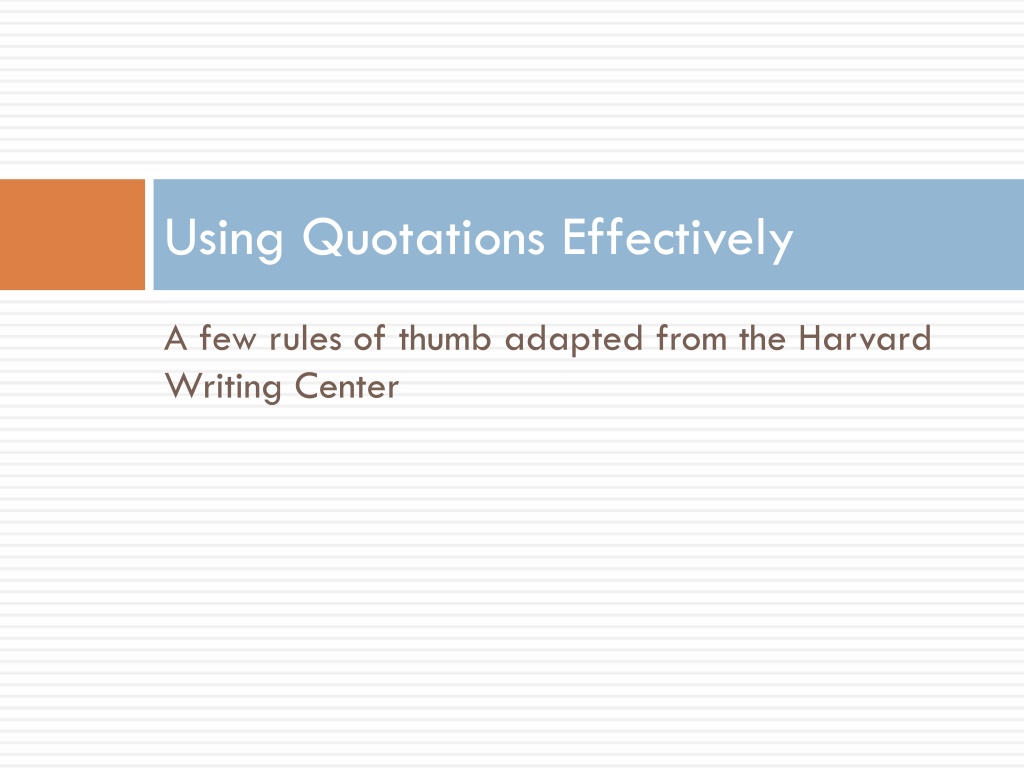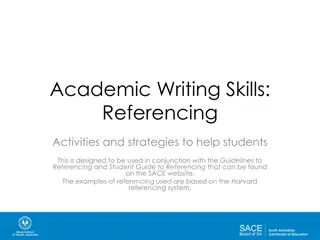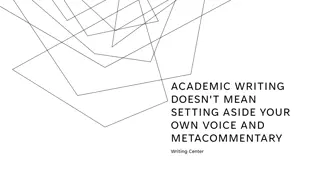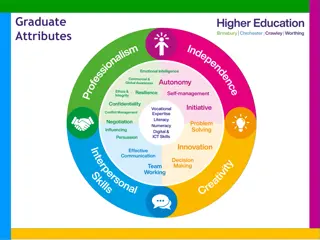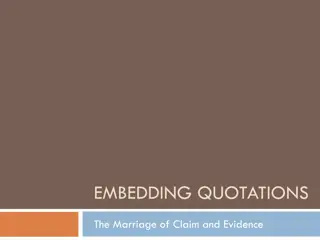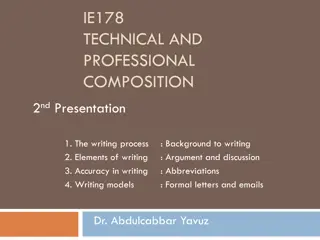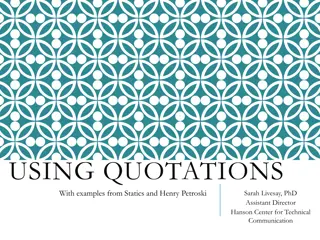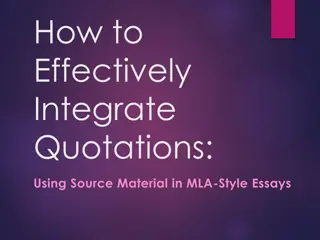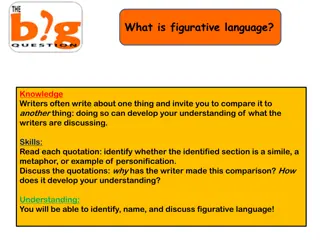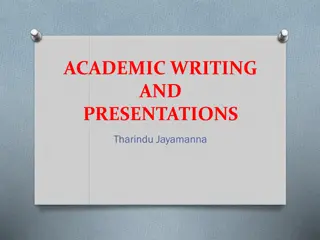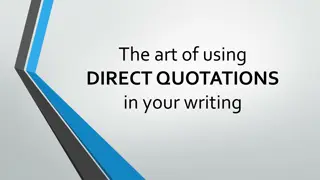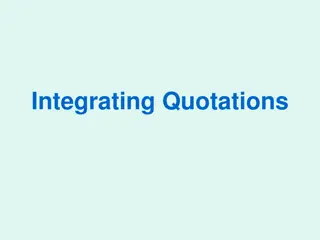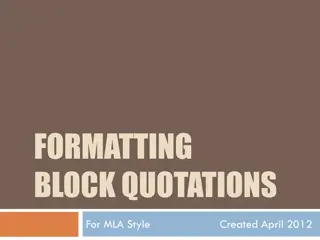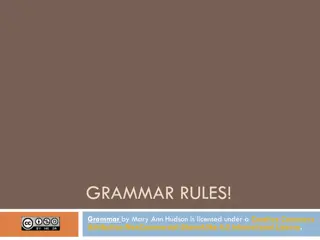Effective Use of Quotations in Academic Writing
To effectively use quotations in academic writing, consider the discipline, topic, and analysis when determining the number of quotes to include. Paraphrase whenever possible, and only use direct quotes for information you can't rephrase. Provide context and analyze quotes instead of merely pasting them in your paper. Avoid long block quotes unless necessary to maintain your voice in the writing.
Download Presentation

Please find below an Image/Link to download the presentation.
The content on the website is provided AS IS for your information and personal use only. It may not be sold, licensed, or shared on other websites without obtaining consent from the author.If you encounter any issues during the download, it is possible that the publisher has removed the file from their server.
You are allowed to download the files provided on this website for personal or commercial use, subject to the condition that they are used lawfully. All files are the property of their respective owners.
The content on the website is provided AS IS for your information and personal use only. It may not be sold, licensed, or shared on other websites without obtaining consent from the author.
E N D
Presentation Transcript
Using Quotations Effectively A few rules of thumb adapted from the Harvard Writing Center
Your Paper, Your Voice There s no magic number of acceptable quotes to include in a paper . . . It depends on the discipline, the topic, & your analysis. Those of you who have taken my classes in the past know that I do limit the number of direct quotes! Ultimately, it s your paper, so your voice should be highlighted and heard (versus the voices of others). Along those lines . . .
Quote What You Cant Paraphrase Most of what you write should be paraphrased putting the ideas of others into your own words. If you can paraphrase it, then do so! If you cannot paraphrase (put it in your own words), then you should quote the original material. If you need to reference the exact words of an author (maybe an authority in the field), or perhaps of an original source document (like a legal document), then you may want to use a direct quote. https://harvardwritingcenter.wordpress.com/2010/05/05/to- quote-or-not-to-quote/
Context & Analysis Are Required If you do directly quote something, DO NOT just cut & paste it into your paper. Instead, you need to first provide context set up for your reader how it relates to your earlier statements and why you are including it. And, provide analysis of the quote don t just let it speak for itself. https://harvardwritingcenter.wordpress.com/2010/05/05/t o-quote-or-not-to-quote/
A first step teachers can take to support students with IDD in going to college is to communicate that college is a possibility. Although high expectations alone are not sufficient to support students with IDD to pursue college, as Grigal and Hart (2012) stated, expectations are an extremely powerful force in determining whether a young person goes to college. And they are equally, if not more powerful, in determining if young people with an intellectual disability will go to college (p. 221). Historically, students with IDD have had neither the opportunity nor the expectation that they would to college, which is why we include setting high expectations as a part of the support that students need.
Beware Block (40+ Word) Quotes I know (from experience) that block quotes are an easy way to make a paper longer especially at the last minute! Resist the temptation to use block quotes unless doing so is really critical (remember: your paper, your voice). Use earlier guidelines to determine if its inclusion is critical. If you include a block quote, you need to provide context for it, and analysis of the whole quote! If you decide to use a block quote, there are particular rules in APA (see pp. 92, 171).
Also Avoid Popular Quotes This isn t a hard rule, but in general, I recommend just avoiding the use of quotes that are popularly known, are adages, or are found in quote books/websites. This is a style choice, and in Special Education & related fields, most academic writing includes quotes from sources in the field.
A first step teachers can take to support students with IDD in going to college is to communicate that college is a possibility. Although high expectations alone are not sufficient to support students with IDD to pursue college, as Grigal and Hart (2012) stated, expectations are an extremely powerful force in determining whether a young person goes to college. And they are equally, if not more powerful, in determining if young people with an intellectual disability will go to college (p. 221). Historically, students with IDD have had neither the opportunity nor the expectation that they would to college, which is why we include setting high expectations as a part of the support that students need.
Make Sure You Follow APA! For quotes less than 40 words: Quote the text exactly If you need to make changes to the original, use brackets [like this] to note the words you added/changed. Enclose the quote with double quotation marks: like this In your in-text citation, you must include The author(s) of the publication The year of the publication If there s no year, you write n.d. where the year would have gone. The page number on which the quote was found If there s no page numbers, you write n.p. where the page number would have gone.
An Example Comma before quote Although high expectations alone are not sufficient to support students with IDD to pursue college, as Grigal and Hart (2012) stated, expectations are an extremely powerful force in determining whether a young person goes to college. And they are equally, if not more powerful, in determining if young people with an intellectual disability will go to college (p. 221). Period after in-text citation
An Example Comma before quote Although high expectations alone are not sufficient to support students with IDD to pursue college, as Grigal and Hart (2012, p. 221) stated, expectations are an extremely powerful force in determining whether a young person goes to college. And they are equally, if not more powerful, in determining if young people with an intellectual disability will go to college. When your sentence ends with a quote, the final punctuation (in this case the period) goes INSIDE the quotation marks.
Another Example Comma before quote Although high expectations alone are not sufficient to support students with IDD to pursue college, expectations are an extremely powerful force in determining whether a young person goes to college. And they are equally, if not more powerful, in determining if young people with an intellectual disability will go to college (Grigal & Hart, 2012, p. 221). Period after in-text citation
This is Not the Whole Story There are specific circumstances and examples that we have not covered that you might encounter. Quoted material within a quotation Making changes to quoted material And more! What should you do when you re not exactly sure how to quote something & format it correctly using APA?
Helpful Resources Your APA Manual!!! https://harvardwritingcenter.wordpress.com/2010/05/0 5/to-quote-or-not-to-quote/ http://writingcenter.unc.edu/handouts/quotations/ http://blog.apastyle.org/apastyle/2013/06/block -quotations-in-apa-style.html http://blog.apastyle.org/apastyle/direct- quotations/ http://www.write.armstrong.edu/handouts/APAstyle .pdf
